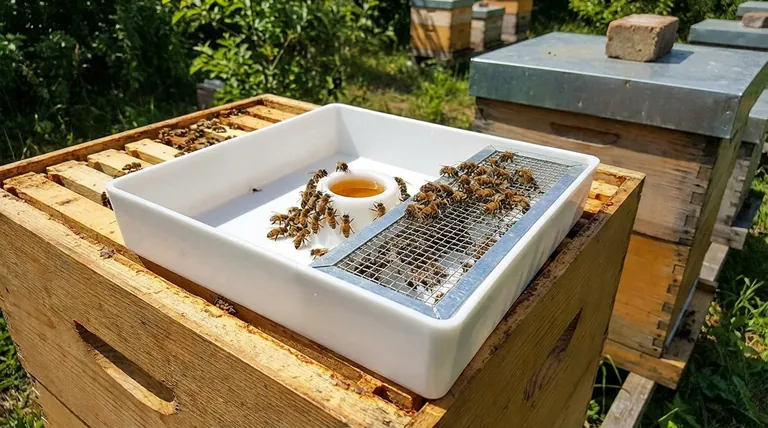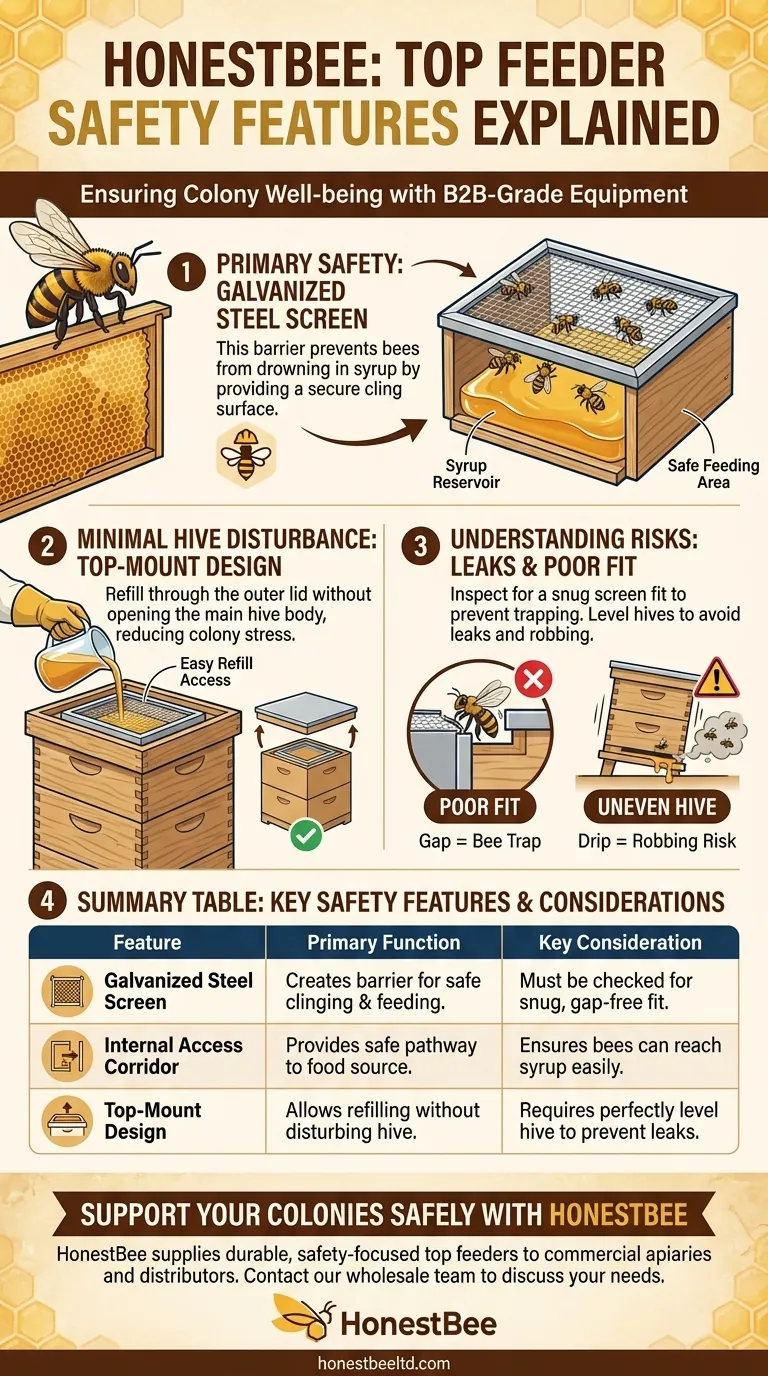The primary safety feature of a top feeder is a galvanized steel screen or similar barrier system. This component is specifically designed to give bees access to the syrup while preventing them from falling in and drowning, which is a significant risk with open-liquid feeders.
While a top feeder is prized for its large capacity and ease of use, its most critical function is providing safe, drowning-free access to food. The effectiveness of this safety system, however, relies on its proper fit and the beekeeper's attention to detail.

How Top Feeders Prioritize Bee Safety
A top feeder's design is a balance between beekeeper convenience and the colony's well-being. The safety features are integrated directly into this core design.
The Critical Role of the Safety Screen
The most prominent safety measure is the screen or access corridor. This barrier separates the main reservoir of syrup from the area where bees can feed.
It creates a surface that bees can securely cling to while they consume the syrup. This prevents them from being submerged in the liquid.
Design for Minimal Hive Disturbance
Top feeders are placed directly on top of the uppermost hive box, under the main hive cover.
This allows a beekeeper to refill the feeder simply by removing the outer lid, without opening the main hive body or breaking the propolis seal on the inner cover.
Minimizing hive disturbance reduces stress on the colony, which is a crucial aspect of maintaining its overall health and defensive posture.
Understanding the Trade-offs and Risks
While effective, the safety of a top feeder is not automatic. Its design introduces specific risks that you must manage.
The Danger of a Poorly Fitted Screen
The most common point of failure is a gap between the safety screen and the feeder walls.
If the screen is warped, damaged, or poorly designed, bees can slip behind it into the main reservoir, where they will become trapped and drown.
Always inspect your feeder to ensure the screen fits snugly with no gaps that a bee could squeeze through.
Potential for Leaks and Robbing
Because top feeders hold a large volume of syrup (often up to three gallons), any leak can be a major problem.
If the hive is not perfectly level or the feeder is not constructed well, syrup can drip down into the hive or out the entrance. This can attract pests and, more dangerously, incite "robbing" from other honeybee colonies, which can devastate a hive.
Making the Right Choice for Your Colony
Your goal determines how you should select and use a top feeder.
- If your primary focus is maximum safety: Always inspect the feeder for a tight, gap-free fit around the safety screen before use, and ensure your hive is perfectly level to prevent leaks.
- If your primary focus is efficiency: The top feeder's large capacity is ideal, but you must not let the convenience lead to complacency. Check for leaks and ensure the bees can easily access the feed without drowning.
- If you are feeding a new or weak colony: Monitor the feeder to confirm the bees are strong enough to climb up and access the feed. If they struggle, an entrance feeder might be a better temporary option.
By understanding both its benefits and its potential points of failure, you can use a top feeder to safely and effectively support your colony's growth.
Summary Table:
| Safety Feature | Primary Function | Key Consideration |
|---|---|---|
| Galvanized Steel Screen | Creates a barrier for bees to cling to, preventing drowning in syrup. | Must be checked for a snug, gap-free fit to be effective. |
| Internal Access Corridor | Provides a safe pathway for bees to access the food source. | Ensures bees can easily reach the syrup without risk. |
| Top-Mount Design | Allows for refilling without disturbing the main hive body, reducing colony stress. | Requires the hive to be perfectly level to prevent leaks. |
Ensure your colony's safety with the right equipment. HONESTBEE supplies durable, well-designed top feeders and other essential beekeeping supplies to commercial apiaries and distributors through our wholesale-focused operations. Our equipment is built with the precise safety features detailed above to help you support your colonies effectively. Contact our team today to discuss your wholesale needs and keep your bees safe and well-fed.
Visual Guide

Related Products
- HONESTBEE Professional Hive Top Bee Feeder Feeding Solution
- Professional Hive Top Bee Feeder for Beekeeping
- HONESTBEE Round Hive Top Bee Feeder for Syrup
- Professional Hive Front Entrance Bee Feeder
- HONESTBEE Entrance Bee Feeder Professional Hive Nutrition Solution for Beekeeping
People Also Ask
- What is the best way to top feed bees? A Safe, High-Volume Feeding Solution for Your Apiary
- How do I keep bees from drowning in my top feeder? Ensure Safe Feeding for Your Hive
- What features make top feeders a reliable choice for beekeepers? A Guide to Safe, Efficient Hive Nutrition
- What is a top feeder for bees? Maximize Colony Health with Efficient Feeding
- How is the plywood floor fitted into the hive-top feeder? Ensure Longevity with a Floating Floor Design



















